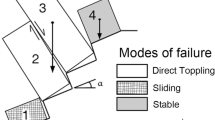Abstract
A stress–strain analysis studying flexural toppling failure in a phyllite mine slope at the Quadrilátero Ferrífero, MG, Brazil is presented in this work. A numerical approach, the discrete element method, capable of representing discontinuous rock mass is used. The modeling of a discontinuous rock mass is complex and problematic. On theother hand, it better represents failure along discontinuities than do continuum techniques such as the finite element method. There are few studies using discontinuous modeling techniques to perform parametric and back-analyses of these types of mechanisms in weak and fractured rock mass. Therefore, the analyses herein can contribute to a better understanding of the geomechanical behavior of discontinuities, especially their stiffness. Also, the influence of in situ stresses in the failure mechanism is studied.














Similar content being viewed by others
References
Adhikary DP, Dyskin AV, Jewell RJ, Stewart DP (1997) A study of the mechanism of flexural toppling failure of rock slopes. Rock Mech Rock Eng 30(2):75–93
Bandis SC, Lumsden AC, Barton N (1983) Fundamentals of rock joint deformation. Int J Rock Mech Min Sci Geomech Abstr 20(6):249–268
Barton N, Choubey V (1977) The shear strength of rock joints in theory and practice. Rock Mech 10(1–2):1–54
Braga Júnior MM (2010) Efeito do scalping de quartzo grosso na flotação catiônica reversa de minério de ferro. M.Sc. Thesis, Graduate Program in Mining and Metallurgy Engineering. Federal University of Minas Gerais (UFMG), Brazil
Figueiredo RP, Aquino TVC (2005) Caracterização e retro-análise preliminar do mecanismo de tombamento flexural - Mina do Pico/MBR. 11 Brazilian Congress of Geological and Environmental Engineering, vol 1. Floranópolis, pp 2274–2287
Franca PRB (1997) Analysis of slope stability using limit equilibrium and numerical methods, with case examples from the Águas Claras Mine, Brazil. M.Sc. Thesis, Queen’s University, Kingston, Ontario
Goodman RE (1989) Introduction to rock mechanics, 2nd edn. Wiley, New York
Lopes MC (2006) Comportamento geotécnico e mecanismos de ruptura em rochas brandas Mina Córrego do Sítio, M.Sc. thesis, Graduate Program in Mining Engineering, Federal University of Ouro Preto, Brazil
Rocscience Inc. (2008) Phase2 Version 7.0—Finite Element Analysis for Excavations and Slopes, Toronto. http://www.rocscience.com
Sheorey PR (1994) A theory for in situ stresses in isotropic and transversely isotropic rock. Int J Rock Mech Min Sci Geomech Abstr 31(1):23–34
Silva CHC (2010) Comportamento geotécnico dos filitos do talude oeste da Mina Pau Branco. M.Sc thesis, Graduate Program in Mineral Engineering, Federal University of Ouro Preto, Brazil
Sjöberg J (1999) Analysis of Large Scale Rock Slopes. Doctoral Thesis Lulea University of Technology
UDEC 4.01 (2004) Itasca Consulting Group, Inc, Minneapolis, USA. http://www.itascag.com
Author information
Authors and Affiliations
Corresponding author
Rights and permissions
About this article
Cite this article
Pinheiro, A.L., Lana, M.S. & Sobreira, F.G. Use of the distinct element method to study flexural toppling at the Pico Mine, Brazil. Bull Eng Geol Environ 74, 1177–1186 (2015). https://doi.org/10.1007/s10064-014-0713-6
Received:
Accepted:
Published:
Issue Date:
DOI: https://doi.org/10.1007/s10064-014-0713-6




